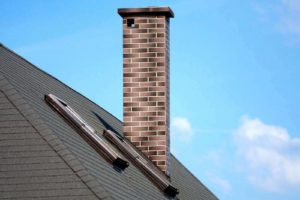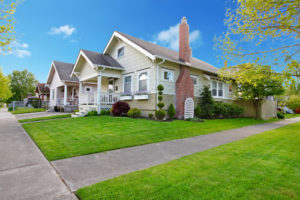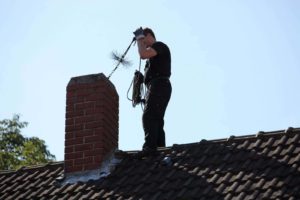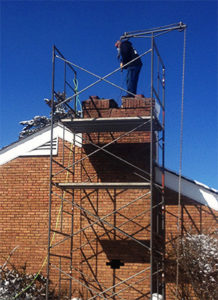A musty smell coming from the fireplace. Smoky odors that come and go in warm weather. Rotting smells from the chimney that start suddenly.
What is causing my stinky chimney?
Chimney odors can start suddenly or build gradually. They can come and go or be constant. No matter what they smell like or how strong they are, chimney odors are the result of a more serious chimney problem. Because of this, it is important to uncover the root cause of the chimney smell, make any necessary repairs, and keep chimney odors from coming back.
What is causing my chimney odor?
There is no one singular cause for chimney odors. Because of this, a chimney inspection by a certified chimney sweep is often needed to uncover the root cause of a stinky chimney. The type of odor it is, how strong it is, how long it has lasted, and other factors can all help a chimney sweep uncover the source of a smell.
There are three primary causes of chimney odors.
1.Animal entry
Type of odor: Sharp, sudden, rotting smell
Cause of odor: Animals in the chimney are more than a nuisance; they can cause serious damage – and serious odors! Sudden, sharp smells accompanying by crying, scurrying, or scratching from the chimney are the most common signs of animal entry. Animal droppings, dried nesting materials, or even dead animals can cause odors that overwhelm the air quality in the home. In addition, animals can introduce microorganisms, pests, and bacteria into your home; because of this, they should be professionally removed as soon as possible.
2. Creosote
Type of odor: Smoky or dirty, especially during humid weather
Cause of odor: Creosote is a naturally occurring byproduct of combustion; it is a dark, sticky substance that accumulates in the flue. When the chimney is not regularly swept or the wrong fuel source has been used, excessive creosote can build up in the flue and cause odors. Smells associated with creosote in the flue are often most noticeable during hot or humid weather.
3. Water entry
Type of odor: Damp or dank
Cause of odor: The exterior of the chimney is designed to not be affected by moisture, but interior fireplace components are not. While they are designed to withstand extremely high heat, even small amounts of moisture from a chimney leak can cause significant problems. Because chimneys are often cool and dark, water has trouble evaporating; these conditions, along with water, can cause mold or mildew growth. This can lead to damp or dank smells – and seriously impact the air quality in the house.
Get rid of your chimney odor with an inspection!
If a chimney odor is affecting the air quality in your home, don’t reach for the air freshener – call a chimney sweep! Contact the experts at Jack Pixley Sweeps today to schedule your next chimney inspection. Our chimney sweeps can help uncover the root cause of your chimney odor, repair any damage, and permanently get rid of your chimney odor.
A chimney inspection is an important diagnostic tool. Homeowners use Inspections to identify the cause of drafting issues. They also use chimney inspections to find damage in the flue liner and assess the structural stability of their chimney. At Jack Pixley Sweeps, we offer 3 levels of chimney inspections to ensure top efficiency and safety of your chimney system.
Three levels of chimney inspection
 In January 2000, the National Fire Protection Agency (NFPA) introduced three standardized levels of chimney inspection. This policy states that “Chimneys, fireplaces, and vents shall be inspected at least once a year for soundness, freedom from deposits, and correct clearances. Cleaning, maintenance, and repairs shall be done if necessary.” These standardized levels of chimney inspections help homeowners feel confident that their system is getting the proper care it needs.
In January 2000, the National Fire Protection Agency (NFPA) introduced three standardized levels of chimney inspection. This policy states that “Chimneys, fireplaces, and vents shall be inspected at least once a year for soundness, freedom from deposits, and correct clearances. Cleaning, maintenance, and repairs shall be done if necessary.” These standardized levels of chimney inspections help homeowners feel confident that their system is getting the proper care it needs.
Level 1 inspections
Level 1 chimney inspections are the most common type of inspection. We perform this level of inspection with regular chimney maintenance, or when your system is not experiencing any performance problems. During this inspection, we inspect all accessible portions of the interior and exterior of the chimney for signs of damage or deterioration.
Level 2 inspections
A level 2 chimney inspection is more intensive than level 1 inspection. In a level 2 chimney inspection, we provide an overview of the condition of the entire chimney system. We recommend level 2 chimney inspections for a new fireplace or insert installation, the relining of a chimney, or when you switched the fuel source in your system. You also need a level 2 inspection before buying or selling a home.
In the level 2 chimney inspections, we use closed-circuit cameras to view inaccessible portions of the chimney. This allows the chimney technician to view the entirety of the flue to check for cracks, damages, blockages, or other chimney issues.
Level 3 inspections
Level 3 chimney inspections are invasive. You only need this inspection if you suspect the structural stability of the chimney is in question. Typically, you will need this chimney inspection after a chimney fire, earthquake, tornado, or other natural disasters. We only use level 3 chimney inspections as a last resort, since this inspection involves removing part of the masonry or surrounding building materials such as bricks, walls, ceilings, siding.
The importance of chimney inspections
“A chimney inspection is like an annual dental check-up,” Director of Education for the CSIA Ashley Eldridge said. “It’s preventative maintenance that helps minimize potential hazards.” Chimney inspections are an important part of maintaining your chimney system. At Jack Pixley Sweeps, we meet all NFPA standards for chimney inspections. In addition, we use Chim-Scan camera systems as a part of all three levels of our chimney inspection.
A chimney inspection is an important diagnostic tool that can help identify the source of an odor. It also ensures your chimney is structurally sound and prepares your home to be sold. For more information on what type of chimney inspection your home need or to schedule your next chimney inspection, contact Jack Pixley Sweeps today!
Warm weather has finally arrived. The warm temperatures and longer days mean many homeowners have finished using their fireplaces until fall. While many of us tend to forget about our fireplaces until the first cold snap of fall, now is actually the perfect time to have chimney maintenance completed.
Spring and summer are the perfect time for chimney repairs!
With hot summer days just around the corner, few homeowners are using their fireplaces. Because of this, spring and summer are the perfect time to have chimney maintenance and repairs completed. Whether it is an annual sweeping, repairs to the masonry or major chimney construction, summer is the perfect time of year to have your fireplace and chimney repaired. Below are three reasons that this is the perfect season for chimney repairs.
- Fireplace use is not disrupted. When chimney repairs are done in the fall or winter, the fireplace cannot be used until the repairs are done. This can be a problem, particularly if cold or inclement weather leads to delays. Having repairs done in the summer does not disrupt fireplace use. The warm temperatures and mild weather mean that repairs can be done on schedule.
- Get an appointment that works with your schedule. Because fireplaces are in heavy use during the fall and winter, they are extremely busy seasons for chimney sweeps. This can make convenient appointment times hard to get or cause weeks-long waiting periods. Spring and summer are slower months, making it easier to get convenient appointment times that work with your schedule.
- Make sure your fireplace is ready for the next burning season. There is no worse feeling than wanting to use your fireplace and realizing it is damaged, dirty, or in need of repairs. Having chimney maintenance done during the summer ensures your fireplace is ready to use when the first cool days of fall arrive.
Schedule your next sweeping or inspection today!
You don’t have to wait until you’re ready to use your fireplace to have it swept and inspected. Spring and summer are the perfect time for chimney maintenance; having your chimney swept after a long burning season ensures it is clean, free from blockages and debris, and ready to use once fall arrives.
A chimney inspection can also be done during the summer to check for any signs of damage or deterioration to the fireplace, flue, and other chimney components. If you are experiencing any fireplace performance problems such as drafting issues or ongoing leaks, a chimney inspection can also be used to diagnose the underlying cause of the problem.
While your fireplace may be the last thing on your mind, this is the best time of year to fix it. To ensure your fireplace is ready to use when fall arrives, contact the chimney experts at Jack Pixley Sweeps today!
Getting ready to sell your home is an difficult process. When a homeowner is ready to put their home on the market, hours are spent cleaning. However, there is one important place in your home that you should not overlook when cleaning – the fireplace.
If you are ready to sell your home, it is important to have a professional the fireplace and chimney sweeping and inspection. A Level II chimney inspection and report by a CSIA certified chimney sweep give potential buyers the peace of mind that the fireplace is in good condition. At Jack Pixley Sweep, all of our sweeps are CSIA certified and we have years of experience, you can trust our sweeps to put your mind at ease.
Have a professional chimney inspection before putting your home on the market
 In addition to packing boxes, staging furniture, and cleaning carpets, you should also schedule a Level II chimney inspection before putting your home on the market. Having your a chimney inspection before listing your house gives a full report of the actual state of your chimney with the disclosures of your home. More importantly, it gives homeowners a chance to make necessary repairs or changes to prevent delays during the transaction of a home.
In addition to packing boxes, staging furniture, and cleaning carpets, you should also schedule a Level II chimney inspection before putting your home on the market. Having your a chimney inspection before listing your house gives a full report of the actual state of your chimney with the disclosures of your home. More importantly, it gives homeowners a chance to make necessary repairs or changes to prevent delays during the transaction of a home.
Some of the most common problems discovered during an inspection are:
- Insufficient clearance between hot surfaces and nearby combustible materials
- Damage to the chimney liner or a liner that is the wrong size
- Flashing that has lost its watertight seal around the base of the chimney
- Moisture damage to the masonry
- Building techniques or components that are not compliant with modern safety standards and codes
What to expect during a Level II chimney inspection
During a Level I chimney inspection, which is performed during chimney maintenance, the sweep inspects all accessible interior and exterior of the fireplace. During a Level II chimney inspection, sweeps use technology such as closed circuit cameras to identify problems within the flue. Buyers may also request their own chimney inspection once the home is in escrow. This is done if there are more questions about the conditions of the fireplace, if an inspection was not done before the home was listed, or if the buyers doubt the findings of the original inspection.
Do I need a chimney inspection AND a home inspection?
Many homeowners and potential buyers believe that a home inspection spot any problems a fireplace has. While home inspectors usually identify major chimney problems such as structural instability, they often lack the training to thoroughly inspect a fireplace system. National Fire Protection Code 211 requires a chimney inspection before the sale of a home. An inspection by a certified chimney sweep can protect both the buyers and sellers during a real estate transaction.
Preparing to sell your home is stressful. having a professional chimney inspection before putting it on the market gives you and the potential buyers peace of mind. For more information on real estate chimney inspections, contact Jack Pixley Sweeps today!
Scaffolding is a necessity for most outdoor construction projects and chimney repairs. However, most chimney companies are not certified to set up and use scaffolding. Instead, these companies contract out scaffolding set up and take down. This can create time delays and additional expenses to your chimney repair project.
At Jack Pixley Sweeps, we have the training and certifications to properly set up and take down scaffolding. While this might seem like a minor distinction, it can save our customers thousands of dollars and time on repair projects.
The importance of being a certified scaffolding pro
 Scaffolding looks deceptively simple. Because it is a vital part of construction projects and chimney repairs, scaffolding setup should only be done by the professionals. Correct scaffolding setup is an important part of ensuring the safety of technicians and the structural stability of the repairs.
Scaffolding looks deceptively simple. Because it is a vital part of construction projects and chimney repairs, scaffolding setup should only be done by the professionals. Correct scaffolding setup is an important part of ensuring the safety of technicians and the structural stability of the repairs.
The crew at Jack Pixley Sweeps have been trained to setup both ground and roof scaffolding. This allows us to set up scaffolding for a wide variety of chimney repair and construction projects. With training from the Occupational Safety and Health Administration (OSHA), our scaffolding always meets safety standards. This protects our crew and your family during the repair or reconstruction process.
The scaffolding set up process
At Jack Pixley Sweeps, we are proud to offer scaffolding set up to our customers. Because every home and repair is different, so is each set up. Depending on the type of repairs you need, the location of the damage, the pitch of the roof, and the height of the chimney, this can all affect the kind of scaffolding construction you need.
Scaffolding set up usually takes an average of two to four hours. During this time, the scaffolding is “tied off”to the home every 20 feet. While scaffolding can usually be anchored to the chimney itself, it may need to be tied off onto the home using anchor bolts. The anchoring process allows additional height to be added to the scaffolding.
Trust the pros at Jack Pixley Sweeps
There are a number of benefits of having professional scaffolding set up done by Jack Pixley Sweeps. First and foremost, we are able to reduce the cost of your chimney repairs – sometimes by as much as $2000 – as the need to find a scaffolding subcontractor is eliminated. Because our crews set up, maintain, and tear down our own scaffolding, we do not need to delay repairs. This also gives our customers additional peace of mind that the only people on their job site are Jack Pixley Sweeps employees!
Scaffolding is an important part of the safety and structural stability of chimney repair projects. Working with trained and certified scaffolding professionals ensure that masons and repair technicians – as well as your family – remain safe throughout the whole repair process. For more information on our professional scaffolding services, contact Jack Pixley Sweeps today!


 In January 2000, the National Fire Protection Agency (
In January 2000, the National Fire Protection Agency (
 In addition to packing boxes, staging furniture, and cleaning carpets, you should also schedule a Level II chimney inspection before putting your home on the market. Having your a chimney inspection before listing your house gives a full report of the actual state of your chimney with the disclosures of your home. More importantly, it gives homeowners a chance to make necessary repairs or changes to prevent delays during the transaction of a home.
In addition to packing boxes, staging furniture, and cleaning carpets, you should also schedule a Level II chimney inspection before putting your home on the market. Having your a chimney inspection before listing your house gives a full report of the actual state of your chimney with the disclosures of your home. More importantly, it gives homeowners a chance to make necessary repairs or changes to prevent delays during the transaction of a home. Scaffolding looks deceptively simple. Because it is a vital part of construction projects and chimney repairs, scaffolding setup should only be done by the professionals. Correct scaffolding setup is an important part of ensuring the safety of technicians and the structural stability of the repairs.
Scaffolding looks deceptively simple. Because it is a vital part of construction projects and chimney repairs, scaffolding setup should only be done by the professionals. Correct scaffolding setup is an important part of ensuring the safety of technicians and the structural stability of the repairs.